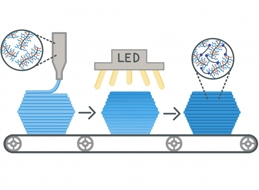
Researchers in the labs of UC Santa Barbara materials assistant professor Chris Bates and professor and department chair, Michael Chabinyc, have teamed up to develop the first 3D-printable “bottlebrush” elastomer. The new material results in printed objects that have unusual softness and elasticity — mechanical properties that closely resemble those of human tissue.
Conventional elastomers, i.e. rubbers, are stiffer than many biological tissues. The reason is related to the size and shape of their constituent polymers, which are long, linear molecules that easily entangle, like a bowl of cooked spaghetti. In contrast, bottlebrush polymers have additional polymers attached to the linear backbone, leading to a structure that is more akin to a bottle brush you might find in your kitchen. The bottlebrush polymer structure imparts the ability to form extremely soft elastomers.
The ability to 3D-print bottlebrush elastomers makes it possible to leverage these unique mechanical properties in applications that require careful control over the dimensions of objects ranging from biomimetic tissue to high-sensitivity electronic devices, such as touch pads, sensors, and actuators.
Two postdoctoral researchers — Renxuan Xie and Sanjoy Mukherjee — played key roles in developing the new material. Their findings were published in the Nov. 13 issue of the journal Science Advances. read more



